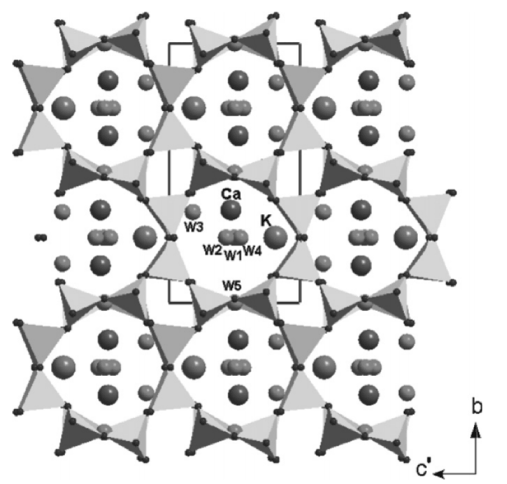The high-pressure (HP) elastic behaviour and the P-induced structural evolution of a natural zeolite phillipsite, K2CanNa2−nAl4+nSi12−nO32 · 12H2O (with n ⩽ 2) [a = 9.9291(3), b = 14.2621(6), c = 8.6920(5) Å, β = 124.592(3)°, space group P21/m], has been investigated by in situ synchrotron X-ray powder diffraction up to 3.64 GPa using a diamond anvil cell and a nominally penetrating hydrous P-transmitting medium. No phase transition has been observed within the P-range investigated. Axial and volume bulk moduli have been calculated using a truncated second-order Birch–Murnaghan Equation-of-State. The refined elastic parameters are: V0 = 1013.3(1) Å3, K0 = 67(2) GPa [β = 0.0149(5) GPa−1] for the unit-cell volume; a0 = 9.9290(7) Å, K(a) = 69(2) GPa [β(a) = 0.0048(2) GPa−1] for the a-axis; b0 = 14.262(2) Å, K(b) = 49(2) GPa [β(b) = 0.0068(3) GPa−1] for the b-axis and c0 = 8.691(1) Å, K(c) = 111(3) GPa [β(c) = 0.00300(8) GPa−1] for the c-axis, with K(a):K(b):K(c) = 1.41:1:2.26. The magnitude of the principal unit-strain coefficients, between 0.0001 GPa and 3.64 GPa, were calculated. The unit-strain ellipsoid is oriented with ε1∥b, ε2 and ε3 lying on the (0 1 0) plane with ε3∠a = 115.1(3)° and ∣ε1∣ > ∣ε2∣ > ∣ε3∣. The structural refinements performed at high-P allow to explain the reasons of the elastic anisotropy. The cooperative rotation of the tetrahedra increase the ellipticity of the channel systems, maintaining the original elliptical configuration (without any “inversion” in ellipticity).












